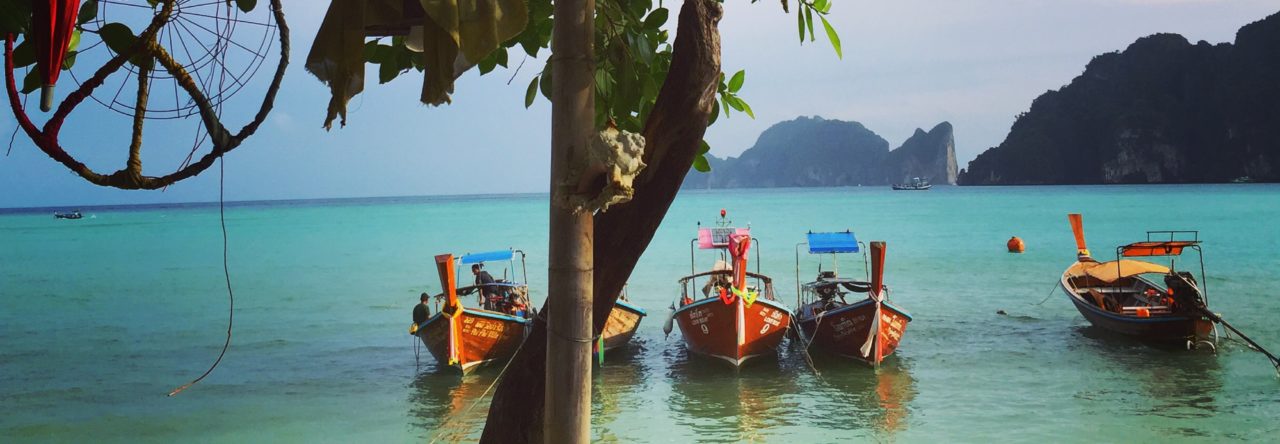Whilst a war was going on in nearby Vietnam, Thailand with all its stability, began to see a growth in visitors through the late-1960s and early-1970s. Phuket, known for its majestic sweeping beaches of white sand entering crystal clear, warm seas, was connected to the mainland by bridge at the end of the 1960s, and this made it easier for travellers to visit. Meanwhile, American soldiers on time off from the war, would flock to Bangkok and the beachtown of Pattaya.
By the 1970s, backpackers were milling with higher-spending tourists, and then began to seek out further, harder to reach paradise islands. Koh Samui over on the east coast started to become popular with adventurous backpackers in the 1970s, and by the 1980s, when that started to get too mainstream, the really adventurous would head over to a little-known island called Koh Pha Ngan. The now infamous Full Moon Party was born.
The growth of backpacker tourism throughout the 1980s, 1990s, and 2000s, saw more and more islands develop with bungalows, travel shops, restaurants, bars, internet cafes, everything a traveller desires.
As is the usual order of things, backpackers lead the way for more mainstream travellers such as those on package tours, and this is how tourism develops, usually. Many of these islands have since gone onto to develop their tourism infrastructure to attract higher spending short-term tourists, rather than long-stay backpackers on a budget. This in fact seems to be a policy of the Tourist Authority of Thailand who seek the economic value of high-spenders. Bamboo bungalows might be replaced with air-con villas, prices go up, and the demographic changes. But as places evolve, new destinations emerge, and there will always be something for everyone, whatever you’re looking for.
So when some think of Thailand these days, their assumption is that everywhere has far too many tourists, travellers, call them, us, yourselves, what you will. As someone who knows Thailand well, from living there for a number of years, to working closely with the country’s tourism infrastructure professionally, I can totally say that that is not true. It takes little effort and imagination to get away from the very touristy parts, and discover the real Thailand. As long as you don’t expect luxuries. If this is what you are seeking, travel has to be about the destination.
Bangkok
As a sprawling city of over eight million people, it is logical that escaping the tourist areas of Bangkok should be easy. And it is. But it is also the case that many travellers will stay in certain areas of the city, such as Khao San Road, for its convenience.
This street and surrounding area is so much fun, and should be experienced, but it is also easy to escape the thousands of travellers that flock here every week. I lived in Bangkok for a number of years, and you can follow this link (to follow) for some insider tips on the most interesting areas to visit in Bangkok.
Thai Islands
There are many islands in the south that we know today as being popular traveller destinations, but until relatively recently, the 80s, and for some of them, the 90s, were reasonably inaccessible. For example, Koh Pha Ngan, a now established tourist island still popular with backpackers but also with families and those seeking more than just a hard bed, fan and a hammock, in the early 1980s was seen as somewhere completely off-the-beaten path, whilst Koh Samui didn’t have many or any paved roads and only had a relatively small amount of basic traveller accommodation. Its airport opened in 1989, and for Koh Samui this changed everything quickly, for neighbouring islands, this also brought about change, although at a much slower pace.
Here, read about my favourite Thai islands, and how to escape the masses and enjoy the peace and tranquility that you would have found on Koh Samui in the early 1980s.
Northeastern Thailand (Isaan)
This part of Thailand is one of the least visited, and in my opinion most under-rated. If you head northeast from Bangkok towards Cambodia and Laos, this is the area we can refer to as Isaan. Culturally the region shares many similarities with Laos, including the dialect that the people of the region speak, and the types of food that is prevalent.
The Isaan region is a place every traveller to Thailand, if they have significant time in the country should visit. Not only is the food some of the best in the country, the people are very friendly, and also the scenery and culture is beautiful and fascinating.
If you want to experience a fascinating part of Thailand that does not have so many foreign visitors, then this is a region not to be missed. Recommendations to follow.
